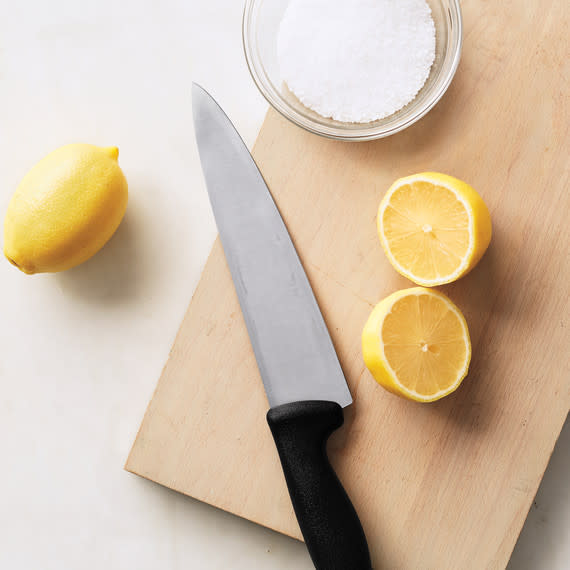Four Steps to Your Sharpest Kitchen Knives Ever

Few tools work as hard as kitchen knives. They slice, dice, chop, and mince—until they don't. To keep them sharp and ready for action, it's important to give those steely blades the proper TLC. Here's how to do just that.
Related: The Three Kitchen Knives Everyone Needs
Clean
Harsh detergents, heat, and jostling can wear on blades, even those labeled as dishwasher-safe. Chef Howie Velie, former director of education at the Culinary Institute of America, in Hyde Park, New York, recommends placing yours flat in the sink, then tilting it a bit so its sharp edge presses gently against the surface. Clean it with a soft scrubby sponge, warm water, and mild dishwashing liquid. Dry it with a dish towel immediately to avoid water spots and bacterial growth. To remove rust or more stubborn stains, rub the blade with lemon and salt.

Hone
Fine-tuning your knife with a honing steel lines up the microscopic fibers of the blade. First, position the steel and blade: Hold steel and knife as shown, with sharp edge of knife pointing away from you. Keeping sharp edge in contact with steel, tilt blade up 20 degrees.

Next, work on one side: Drag blade from handle of steel out to its tip. At the same time, slide blade from heel to point against steel, so that steel has made contact with entire length of blade by the time you reach steel's tip.

Then the other: With heel of blade under steel near its handle, tilt blade 20 degrees and slide sharp edge toward tip. At the same time, drag blade from heel to point. Repeat honing 10 times on each side.

Sharpen
A sharpening stone grinds away metal to form a new edge. Use it at least once a month. If you have a whetstone, submerge it in water until there are no visible air bubbles before using.
Position stone horizontally, coarse-side up, on a damp towel to prevent sliding. Lay upper portion of blade's sharp edge against surface of stone, near its left end. Tilt blade 20 degrees, with sharp edge in contact with stone. Slide sharp edge to right, across stone, applying pressure with help from your free hand, as shown. At the same time, move knife toward top edge of stone so that blade's lower edge comes in contact with stone by the time you reach its right end. To work on blade's other side, start at stone's right end and tilt blade in opposite direction. Repeat sharpening 10 times on each side.

Store
Give knives their space! Keeping them loose in a drawer isn't just dangerous for those reaching in; it's a hazard for the blades: All that moving around can dull them and loosen them from their handles. Our test-kitchen team prefers to store knives in an in-drawer tray like the seven-slot knife organizer above. You can also place them on a magnetic wall strip or in a knife block to wooden. If you choose the latter, says Velie, a wooden block (as opposed to stone or plastic) is gentlest on the blades.